Synthesis and Characterization of Novel Uracil-Modified Chitosan as a Promising Adsorbent for Efficient Removal of Congo Red Dye
Abstract
:1. Introduction
2. Materials and Methods
2.1. Materials
2.2. Preparation of Novel Uracil-Modified Chitosan (UCs) Adsorbent
2.3. Measurements
2.3.1. FTIR Spectroscopy
2.3.2. X-ray Diffractometry
2.3.3. Scanning Electron Microscopy
2.4. Adsorption Studies
2.4.1. Standard Curve of CR Dye
2.4.2. Adsorption of CR Dye Using UCs Adsorbent
2.4.3. Kinetic Studies
2.4.4. Adsorption Isotherm for CR Dye 9
2.4.5. Thermodynamic Studies
2.4.6. Activation Energy
2.4.7. Desorption Study
3. Results and Discussion
3.1. Synthesis of Novel UCs Adsorbent
3.2. Characterization of Novel UCs Adsorbent
3.2.1. FTIR Spectra of UCs Adsorbent
3.2.2. Powder X-ray Diffraction of UCs Adsorbent
3.2.3. SEM Analysis of UCs Adsorbent
3.3. Adsorption of CR Dye Using UCs Adsorbent
3.3.1. Optimization of the Adsorption Conditions
Effect of pH
Effect of Temperature
Impact of Initial Concentration of the Dye
3.3.2. Adsorption Kinetics
At Different pH
At Different Temperatures
At Different Initial Dye Concentrations
3.3.3. Mechanism of CR Dye Adsorption onto UCs
The Intraparticle Diffusion
3.3.4. Adsorption Isotherm
3.3.5. Adsorption Thermodynamics
3.3.6. Activation Energy
3.3.7. Comparison between UCs and Other Adsorbents for CR Dye Removal
3.3.8. Desorption Studies
4. Conclusions
Author Contributions
Funding
Institutional Review Board Statement
Informed Consent Statement
Data Availability Statement
Conflicts of Interest
References
- Owa, F.W. Water pollution: Sources, effects, control and management. Int. Lett. Nat. Sci. 2014, 8, 1–6. [Google Scholar] [CrossRef] [Green Version]
- Necibi, M.; Mzoughi, N. Chapter 1: The distributation of organic and inorganic pollutants in marine environment. In Micropollutants: Sources, Ecotoxicological Effects and Control Strategies; Tabitha, N., Ed.; Nova Science Publishers, Inc.: London, UK, 2017; pp. 1–44. [Google Scholar]
- Kulik, N.; Panova, Y.; Trapido, M. The Fenton Chemistry and Its Combination with Coagulation for Treatment of Dye Solutions. Sep. Sci. Technol. 2007, 42, 1521–1534. [Google Scholar] [CrossRef]
- Bafana, A.; Saravana Devi, S.; Chakrabarti, T. Azo Dyes: Past, Present and the Future. Environ. Rev. 2011, 19, 350–371. [Google Scholar] [CrossRef]
- Hassaan, M.A.; El Nemr, A. Health and Environmental Impacts of Dyes: Mini Review. Am. J. Environ. Sci. Eng. 2017, 1, 64–67. [Google Scholar]
- Zuorro, A.; Lavecchia, R.; Monaco, M.M.; Iervolino, G.; Vaiano, V. Photocatalytic degradation of azo dye reactive violet 5 on Fe-doped titania catalysts under visible light irradiation. Catalysts 2019, 9, 645. [Google Scholar] [CrossRef] [Green Version]
- Naseem, K.; Farooqi, Z.H.; Begum, R.; Irfan, A. Removal of Congo red dye from aqueous medium by its catalytic reduction using sodium borohydride in the presence of various inorganic nano-catalysts: A review. J. Clean. Prod. 2018, 187, 296–307. [Google Scholar] [CrossRef]
- Kaykhaii, M.; Sasani, M.; Marghzari, S. Removal of Dyes from the Environment by Adsorption Process. Chem. Mater. Eng. 2018, 6, 31–35. [Google Scholar] [CrossRef] [Green Version]
- Crini, G. Non-conventional low-cost adsorbents for dye removal: A review. Bioresour. Technol. 2006, 97, 1061–1085. [Google Scholar] [CrossRef]
- Ravi Kumar, M.N.V. A review of chitin and chitosan applications. React. Funct. Polym. 2000, 46, 1–27. [Google Scholar] [CrossRef]
- Mohamed, N.A.; Abd El-Ghany, N.A. Synthesis, characterization, and antimicrobial activity of carboxymethyl chitosan-graft-poly(N-acryloyl,N′-cyanoacetohydrazide) copolymers. J. Carbohydr. Chem. 2012, 31, 220–240. [Google Scholar] [CrossRef]
- Abraham, A.; Soloman, A.; Rejin, V.O. Preparation of chitosan-polyvinyl alcohol blends and studies on thermal and mechanical properties. Procedia Technol. 2016, 24, 741–748. [Google Scholar] [CrossRef] [Green Version]
- Elmehbad, N.Y.; Mohamed, N.A. Terephthalohydrazido cross-linked chitosan hydrogels: Synthesis, characterization and applications. Int. J. Polym. Mater. Polym. Biomater. 2021, 1–14. [Google Scholar] [CrossRef]
- Elsayed, N.H.; Monier, M.; Youssef, I. Fabrication of photo-active trans-3-(4-pyridyl)acrylic acid modified chitosan. Carbohydr. Polym. 2017, 172, 1–10. [Google Scholar] [CrossRef]
- Mohamed, N.A.; El-Ghany, N.A.A. Novel aminohydrazide cross-linked chitosan filled with multi-walled carbon nanotubes as antimicrobial agents. Int. J. Biol. Macromol. 2018, 115, 651–662. [Google Scholar] [CrossRef]
- Mohamed, N.A.; El-Ghany, N.A.A. Synthesis, characterization and antimicrobial activity of novel aminosalicylhydrazide cross linked chitosan modified with multi-walled carbon nanotubes. Cellulose 2019, 26, 1141–1156. [Google Scholar] [CrossRef]
- Mohamed, N.A.; Al-Harby, N.F.; Almarshed, M.S. Enhancement of adsorption of Congo red dye onto novel antimicrobial trimellitic anhydride isothiocyanate-cross-linked chitosan hydrogels. Polym. Bull. 2020, 77, 6135–6160. [Google Scholar] [CrossRef]
- Alharby, N.F.; Almutairi, R.S.; Mohamed, N.A. Adsorption Behavior of Methylene Blue Dye by Novel Crosslinked O-CM-Chitosan Hydrogel in Aqueous Solution: Kinetics, Isotherm and Thermodynamics. Polymers 2021, 13, 3659. [Google Scholar] [CrossRef]
- Surikumaran, H.; Mohamad, S.; Sarih, N.M. Molecular Imprinted Polymer of Methacrylic Acid Functionalised β-Cyclodextrin for Selective Removal of 2,4-Dichlorophenol. Int. J. Mol. Sci. 2014, 15, 6111–6136. [Google Scholar] [CrossRef] [Green Version]
- Mohamed, N.A.; El-Ghany, N.A.A. Synthesis, characterization, and antimicrobial activity of chitosan hydrazide derivative. Int. J. Polym. Mater. Polym. Biomater. 2017, 66, 410–415. [Google Scholar] [CrossRef]
- Zuorro, A.; Moreno-Sader, K.A.; González-Delgado, A.D. Inherent safety analysis and sustainability evaluation of chitosan production from shrimp exoskeleton in colombia. Water 2021, 13, 553. [Google Scholar] [CrossRef]
- Elmehbad, N.Y.; Mohamed, N.A. Designing, preparation and evaluation of the antimicrobial activity of biomaterials based on chitosan modified with silver nanoparticles. Int. J. Biol. Macromol. 2020, 151, 92–103. [Google Scholar] [CrossRef] [PubMed]
- Wu, B.; Wang, Y.; Chen, S.; Wang, M.; Ma, M.; Shi, Y.; Wang, X. Bis-uracil based high efficient heat stabilizers used in super transparent soft poly (vinyl chloride). Polym. Degrad. Stab. 2018, 149, 143–151. [Google Scholar] [CrossRef]
- Burkhanova, N.; Yugai, S.; Pulatova, K.P.; Nikononvich, G.; Milusheva, R.Y.; Voropaeva, N.; Rashidova, S.S. Structural investigations of chitin and its deacetylation products. Chem. Nat. Compd. 2000, 36, 352–355. [Google Scholar] [CrossRef]
- Feng, T.; Zhang, F.; Wang, J.; Wang, L. Application of Chitosan-Coated Quartz Sand for Congo Red Adsorption from Aqueous Solution. J. Appl. Polym. Sci. 2013, 125, 1766–1772. [Google Scholar] [CrossRef]
- Salama, H.E.; Saad, G.R.; Sabaa, M.W. Synthesis, characterization, and biological activity of cross-linked chitosan biguanidine loaded with silver nanoparticles. J. Biomater. Sci. Polym. Ed. 2016, 27, 1880–1898. [Google Scholar] [CrossRef] [PubMed]
- El-Harby, N.F.; Ibrahim, S.M.A.; Mohamed, N.A. Adsorption of Congo red dye onto antimicrobial terephthaloyl thiourea cross-linked chitosan hydrogels. Water Sci. Technol. 2017, 76, 2719–2732. [Google Scholar] [CrossRef] [PubMed]
- Guarın, J.R.; Moreno-Pirajan, J.C.; Giraldo, L. Kinetic Study of the Bioadsorption of Methylene Blue on the Surface of the Biomass Obtained from the Algae D. antarctica. J. Chem. 2018, 2018, 2124845. [Google Scholar] [CrossRef] [Green Version]
- Swan, N.B.; Abbas, M.; Zaini, A. Adsrption of Malachite green and Congo red dyes from water: Recent progress and future outlook. Ecol. Chem. Eng S 2019, 26, 119–132. [Google Scholar]
- Banerjee, S.; Chattopadhyaya, M.C. Adsorption characteristics for the removal of a toxic dye, tartrazine from aqueous solutions by a low cost agricultural by-product. Arab. J. Chem. 2017, 10, S1629–S1638. [Google Scholar] [CrossRef] [Green Version]
- Ojedokun, A.T.; Bello, O.S. Kinetic modeling of liquid-phase adsorption of Congo red dye using guava leaf-based activated carbon. Appl. Water Sci. 2017, 7, 1965–1977. [Google Scholar] [CrossRef] [Green Version]
- Haque, A.N.M.A.; Remadevi, R.; Wang, X.; Naebe, M. Adsorption of anionic Acid Blue 25 on chitosan-modified cotton gin trash film. Cellulose 2020, 27, 9437–9456. [Google Scholar] [CrossRef]
- Kumar, R.; Ansari, S.A.; Barakat, M.A.; Aljaafari, A.; Cho, M.H. A polyaniline@MoS2-based organic–inorganic nanohybrid for the removal of Congo red: Adsorption kinetic, thermodynamic and isotherm studies. New J.Chem. 2018, 42, 18802–18809. [Google Scholar] [CrossRef]
- Lin, C.; Li, S.; Chen, M.; Jiang, R. Removal of Congo red dye by gemini surfactant C12-4-C12 · 2Br-modified chitosan hydrogel beads. J. Dispers. Sci. Technol. 2017, 38, 46–57. [Google Scholar] [CrossRef]
- Ojedokun, A.T.; Bell, O.S. Liquid phase adsorption of Congo red dye on functionalized corn cobs. J. Dispers. Sci. Technol. 2017, 38, 1285–1294. [Google Scholar] [CrossRef]
- Litefti, K.; Freire, M.S.; Stitou, M.; González-Álvarez, J. Adsorption of an anionic dye (Congo red) from aqueous solutions by pine bark. Sci. Rep. 2019, 9, 16530. [Google Scholar] [CrossRef] [Green Version]
- Tahira, I.; Aslam, Z.; Abbas, A.; Monim-ul-Mehboob, M.; Ali, S.; Asghar, A. Adsorptive removal of acidic dye onto grafted chitosan: A plausible grafting and adsorption mechanism. Int. J. Biol. Macromol. 2019, 136, 1209–1218. [Google Scholar] [CrossRef]
- Zuorro, A.; Maffei, G.; Lavecchia, R. Kinetic modeling of azo dye adsorption on non-living cells of nannochloropsis oceanica. J. Environ. Chem. Eng. 2017, 5, 4121–4127. [Google Scholar] [CrossRef]
- Zahir, A.; Aslam, Z.; Kamal, M.S.; Ahmad, W.; Abbas, A.; Shawabkeh, R.A. Development of novel cross-linked chitosan for the removal of anionic Congo red dye. J. Mol. Liq. 2017, 244, 211–218. [Google Scholar] [CrossRef]
- Bulut, Y.; Karaer, H. Adsorption of Methylene Blue from Aqueous Solution by Crosslinked Chitosan/Bentonite Composite. J. Dispers. Sci. Technol. 2015, 36, 61–67. [Google Scholar] [CrossRef]
- Jabar, J.M.; Odusote, Y.A.; Alabi, K.A.; Ahmed, I.B. Kinetics and mechanisms of congo-red dye removal from aqueous solution using activated Moringa oleifera seed coat as adsorbent. Appl. Water Sci. 2020, 10, 136. [Google Scholar] [CrossRef]
- Dbik, A.; Bentahar, S.; El Khomri, M.; El Messaoudi, N.; Lacherai, A. Adsorption of Congo red dye from aqueous solutions using tunics of the corm of the saffron. Mater. Today 2020, 22, 134–139. [Google Scholar] [CrossRef]
- Cai, L.; Ying, D.; Liang, X.; Zhu, M.; Lin, X.; Xu, Q.; Cai, Z.; Xu, X.; Zhang, L. A novel cationic polyelectrolyte microsphere for ultrafast and ultra-efficient removal of heavy metal ions and dyes. Chem. Eng. J. 2021, 410, 128404. [Google Scholar] [CrossRef]
- Lafi, R.; Montasser, I.; Hafiane, A. Adsorption of Congo red dye from aqueous solutions by prepared activated carbon with oxygen-containing functional groups and its regeneration. Adsorpt. Sci. Technol. 2019, 37, 160–181. [Google Scholar] [CrossRef] [Green Version]
- Xu, X.; Yu, J.; Liu, C.; Yang, G.; Shi, L.; Zhuang, X. Xanthated chitosan/cellulose sponges for the efficient removal of anionic and cationic dyes. React. Funct. Polym. 2021, 31, 104840. [Google Scholar] [CrossRef]
- Xu, G.; Zhu, Y.; Wang, X.; Wang, S.; Cheng, T.; Ping, R.; Cao, J.; Lv, K. Novel chitosan and Laponite based nanocomposite for fast removal of Cd(II), methylene blue and Congo red from aqueous solution. e-Polymers 2019, 19, 244–256. [Google Scholar] [CrossRef]
- Wang, P.; Yan, T.; Wang, L. Removal of Congo Red from Aqueous Solution Using Magnetic Chitosan Composite Microparticles. BioResources 2013, 8, 6026–6043. [Google Scholar] [CrossRef]
- Mohamed, N.A.; Al-Harby, N.F.; S, M. Almarshed, Effective removal of Basic Red 12 dye by novel antimicrobial trimellitic anhydride isothiocyanate-cross linked chitosan hydrogels. Polym. Polym. Compos. 2021, 29, S274–S287. [Google Scholar]

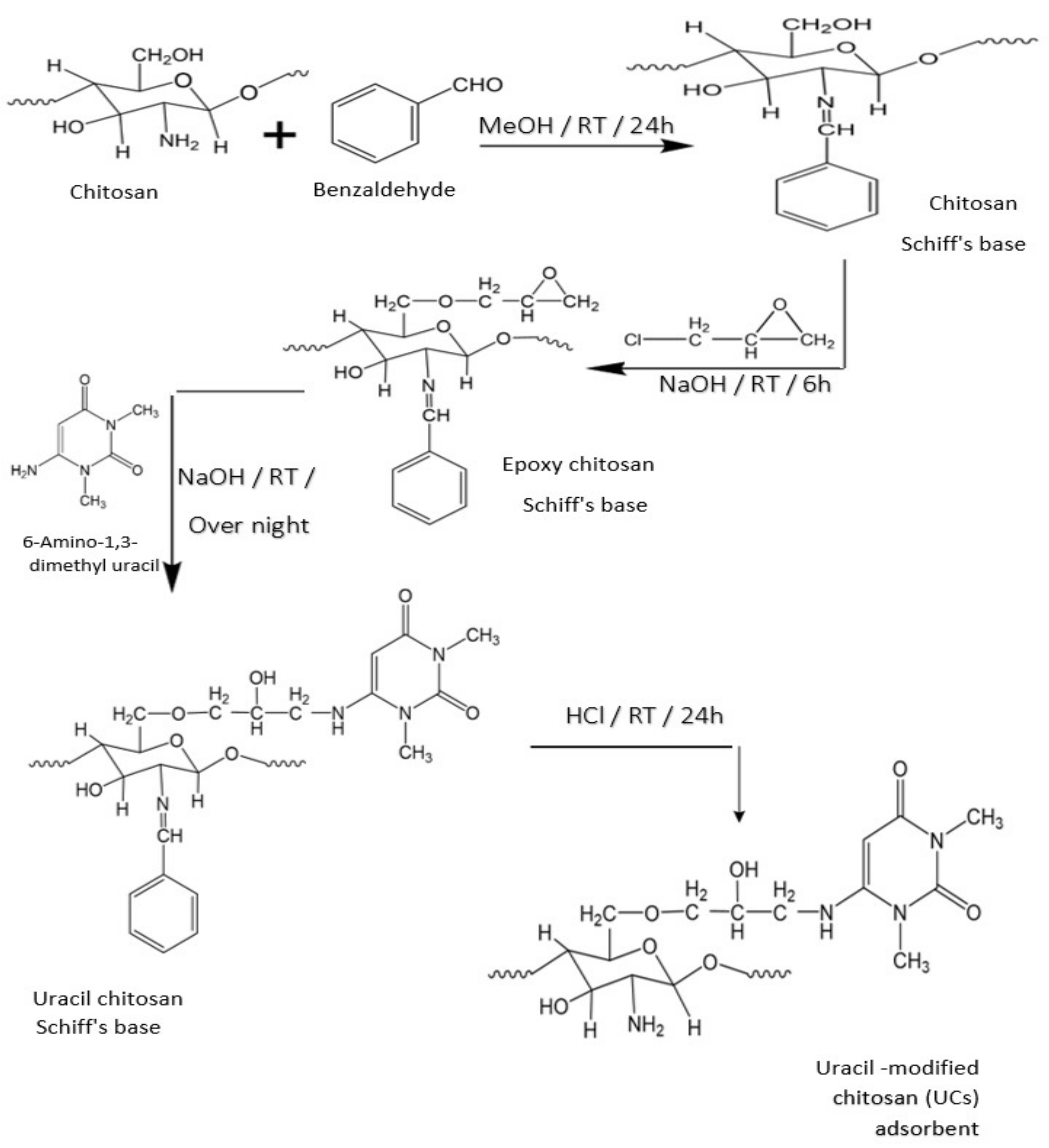

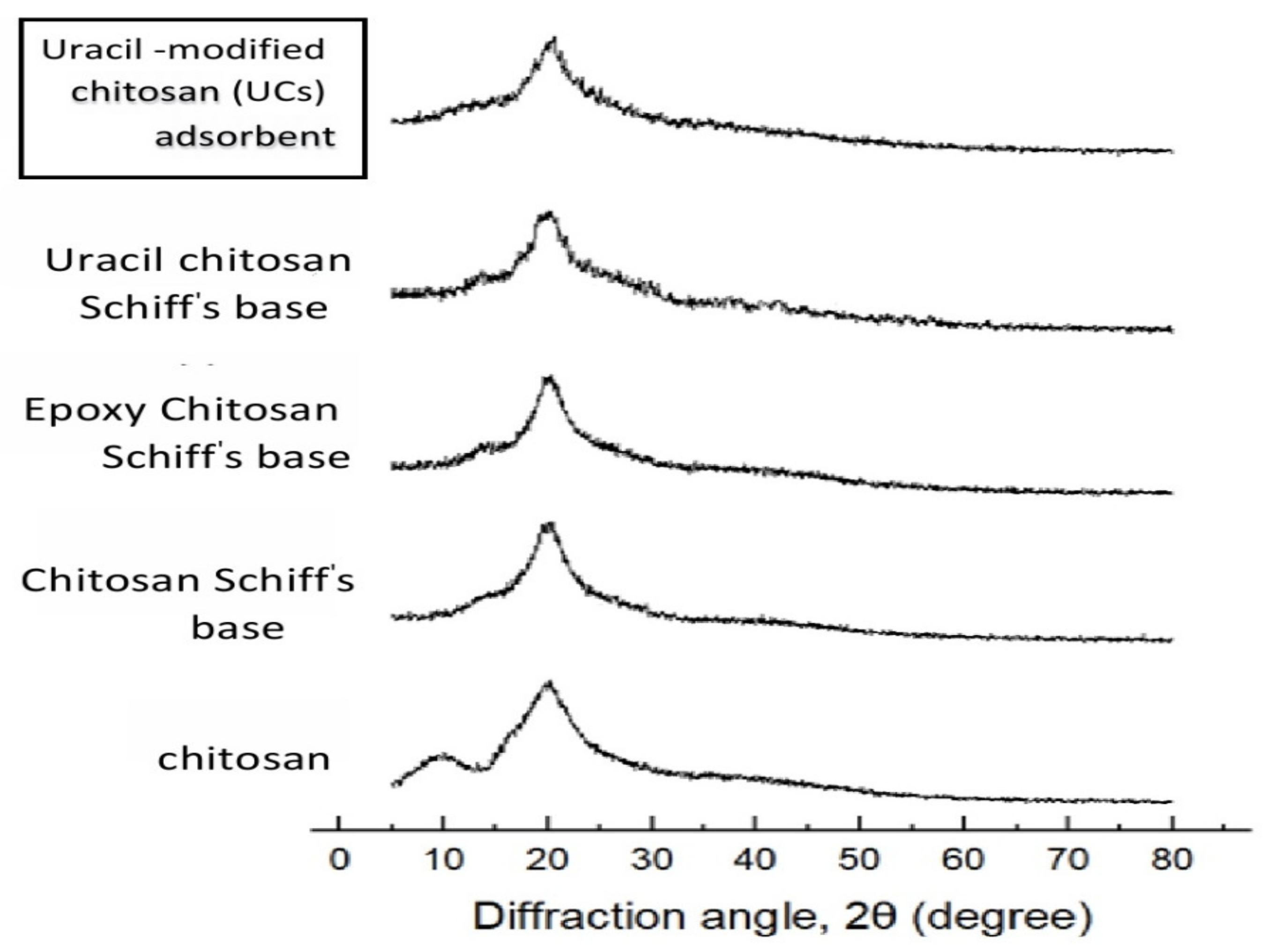
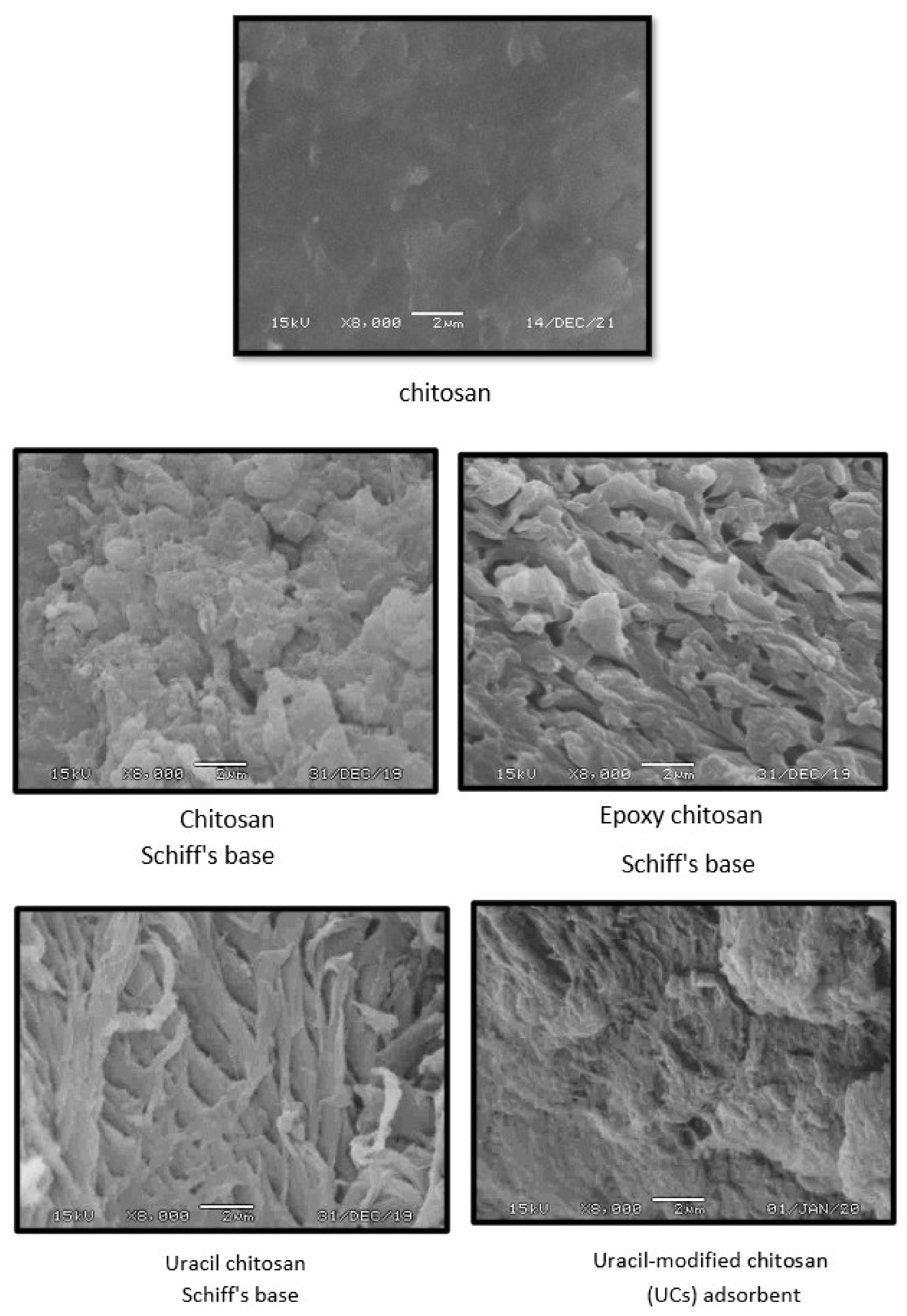
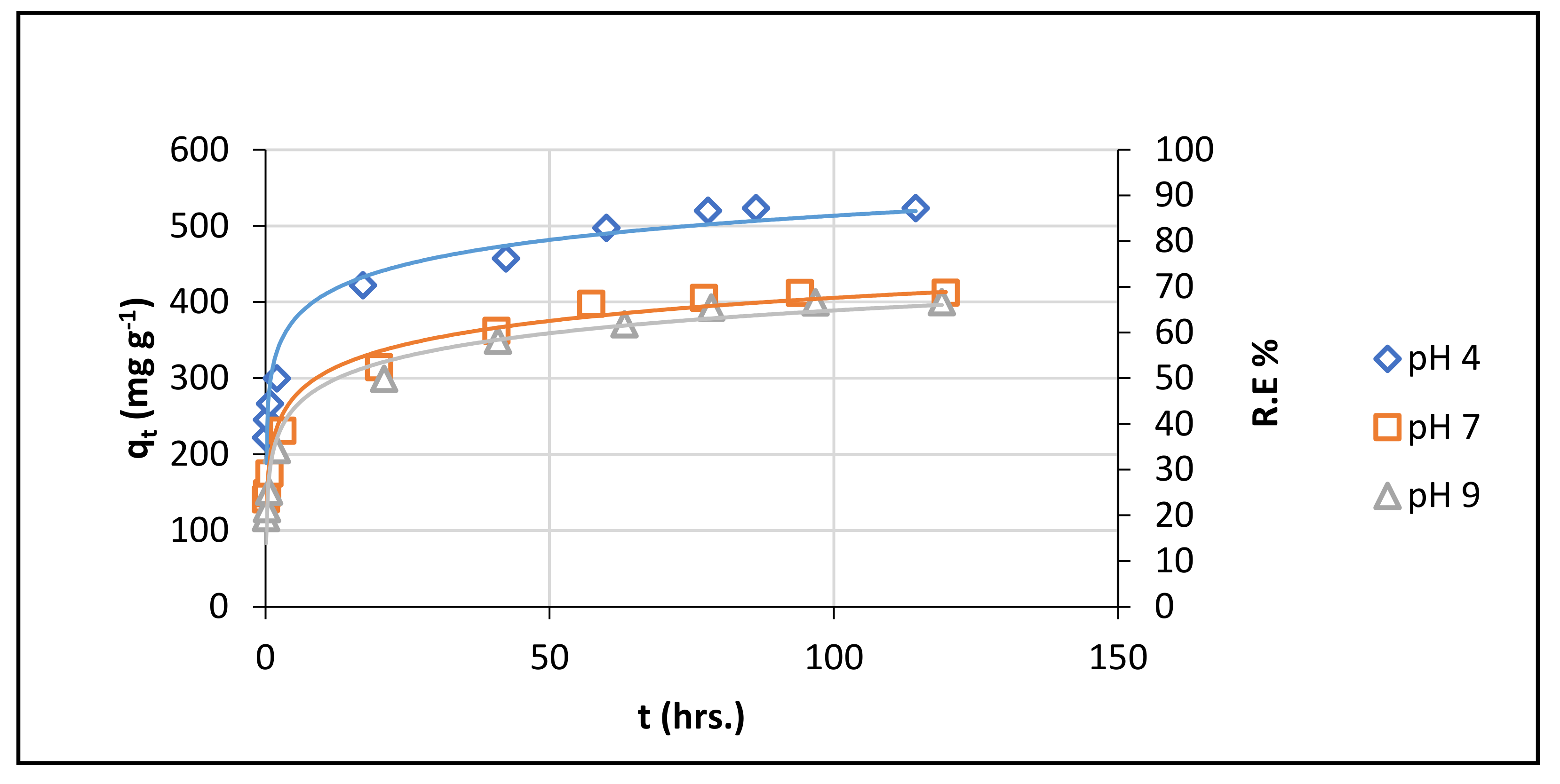
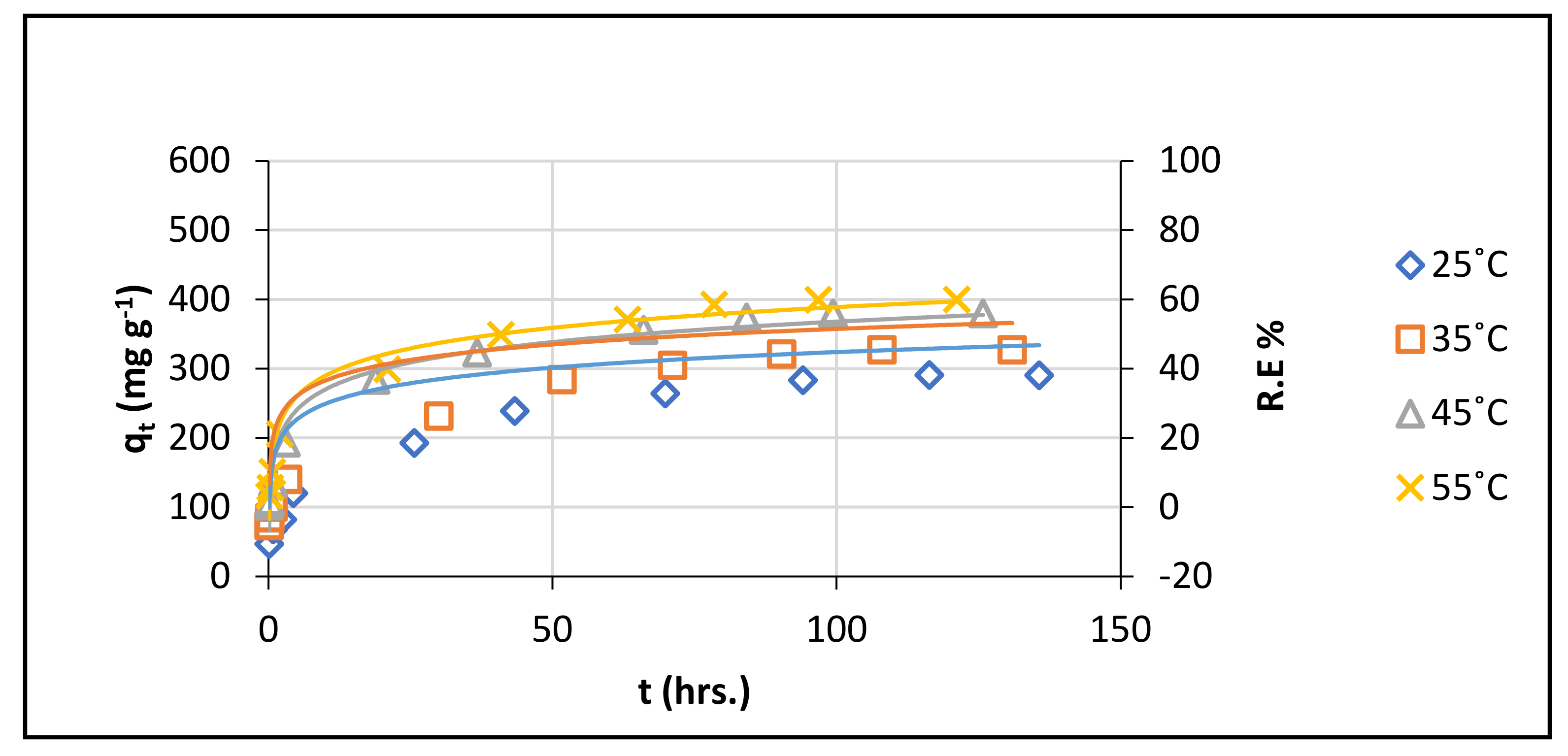

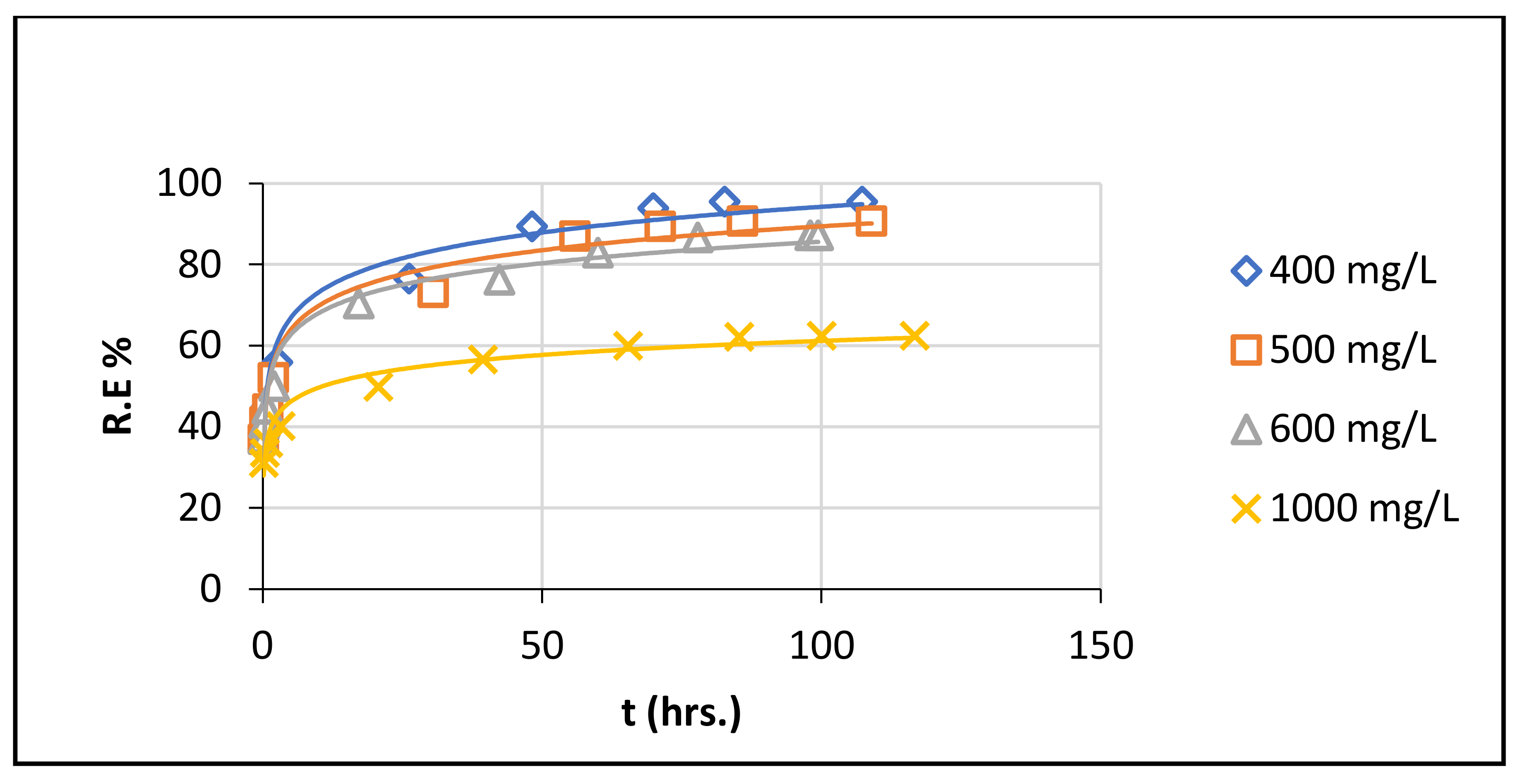
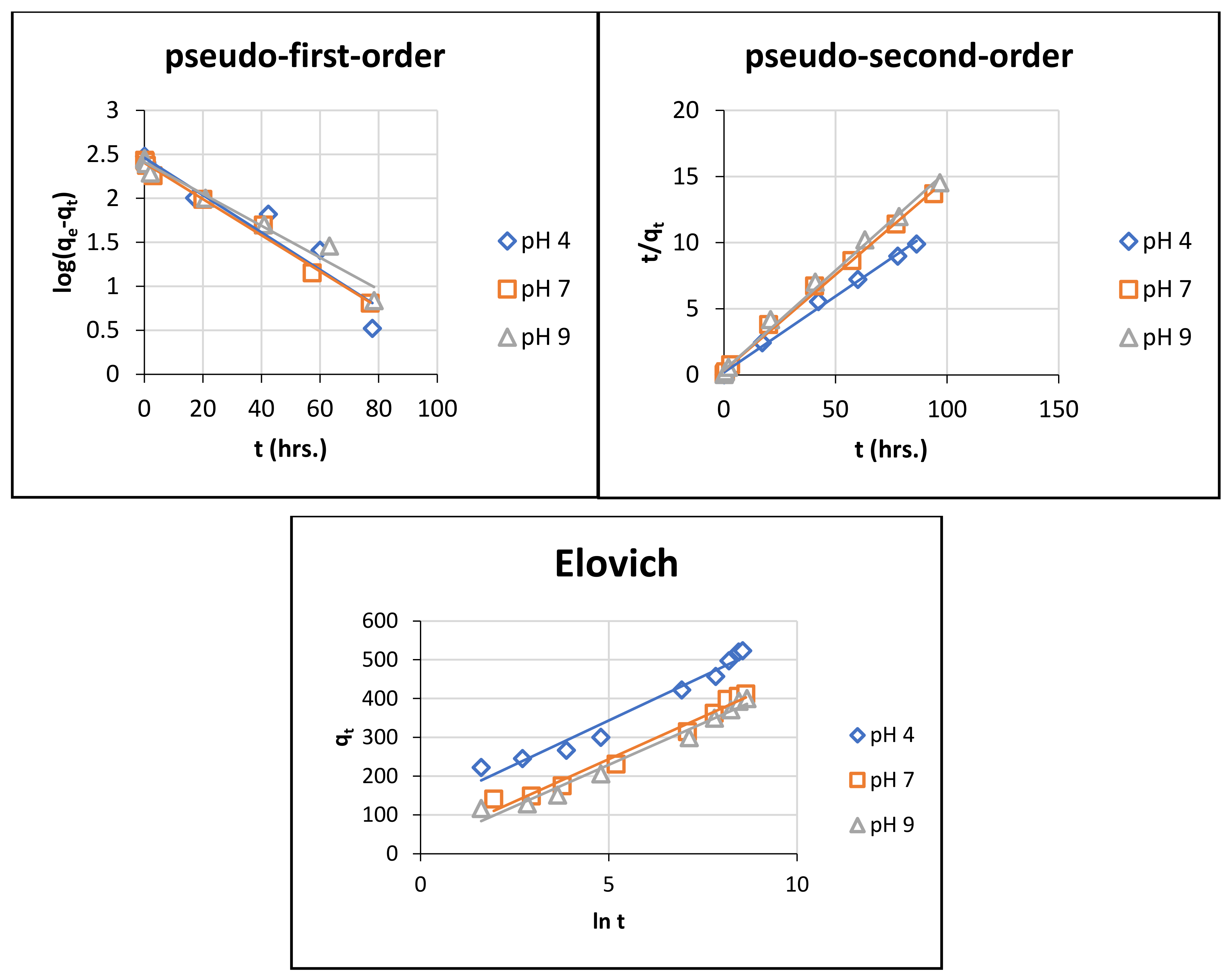
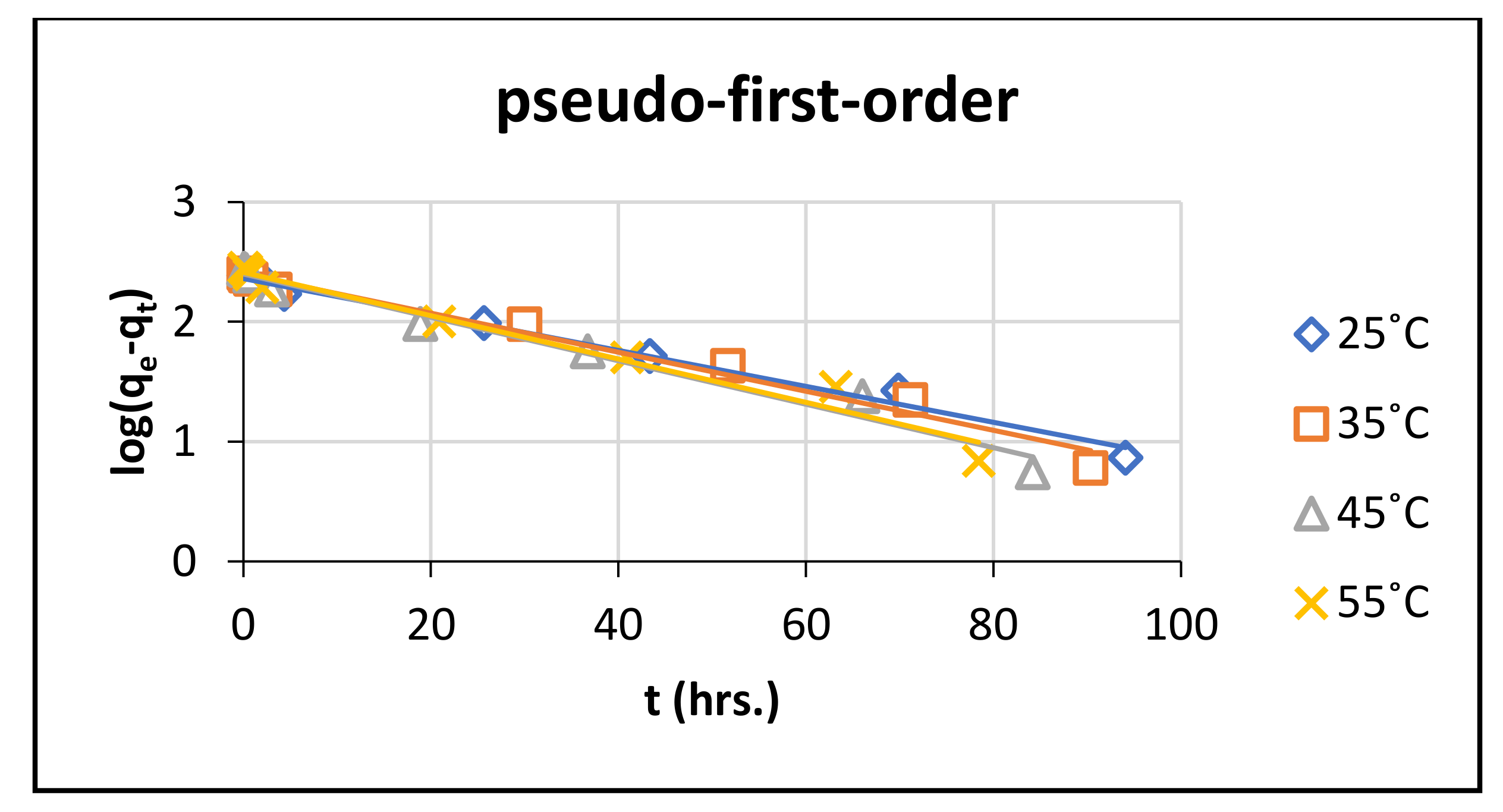
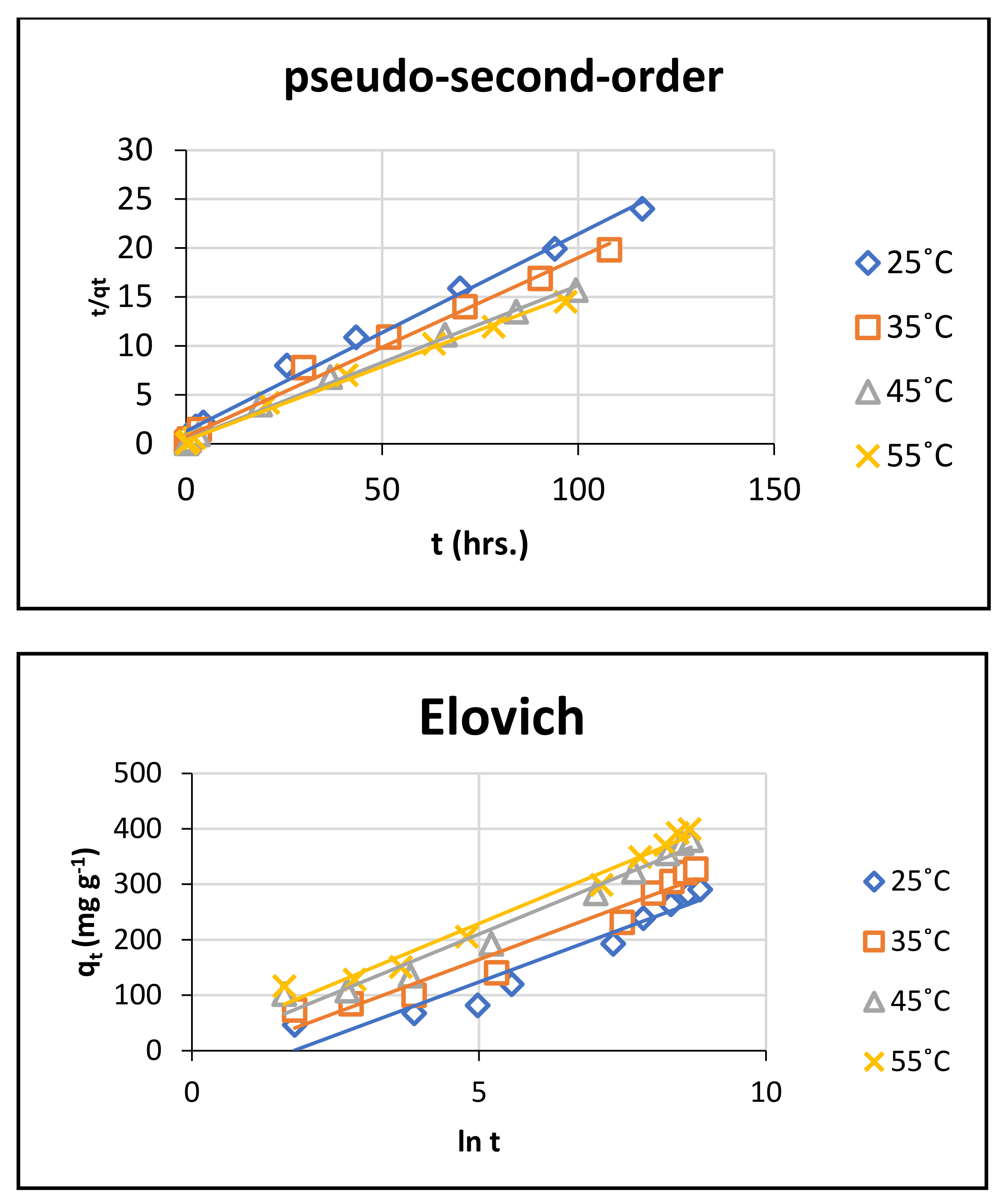
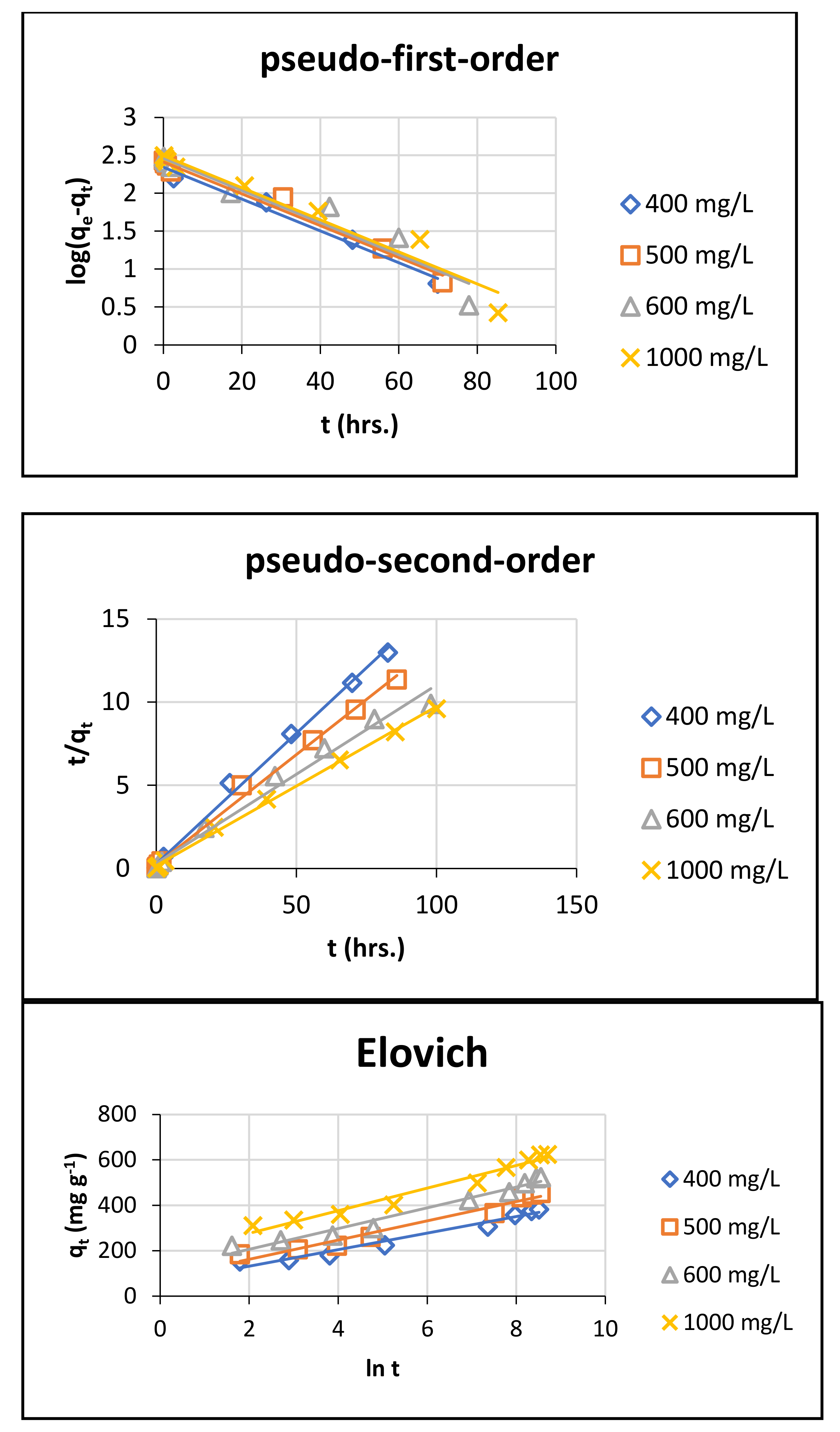
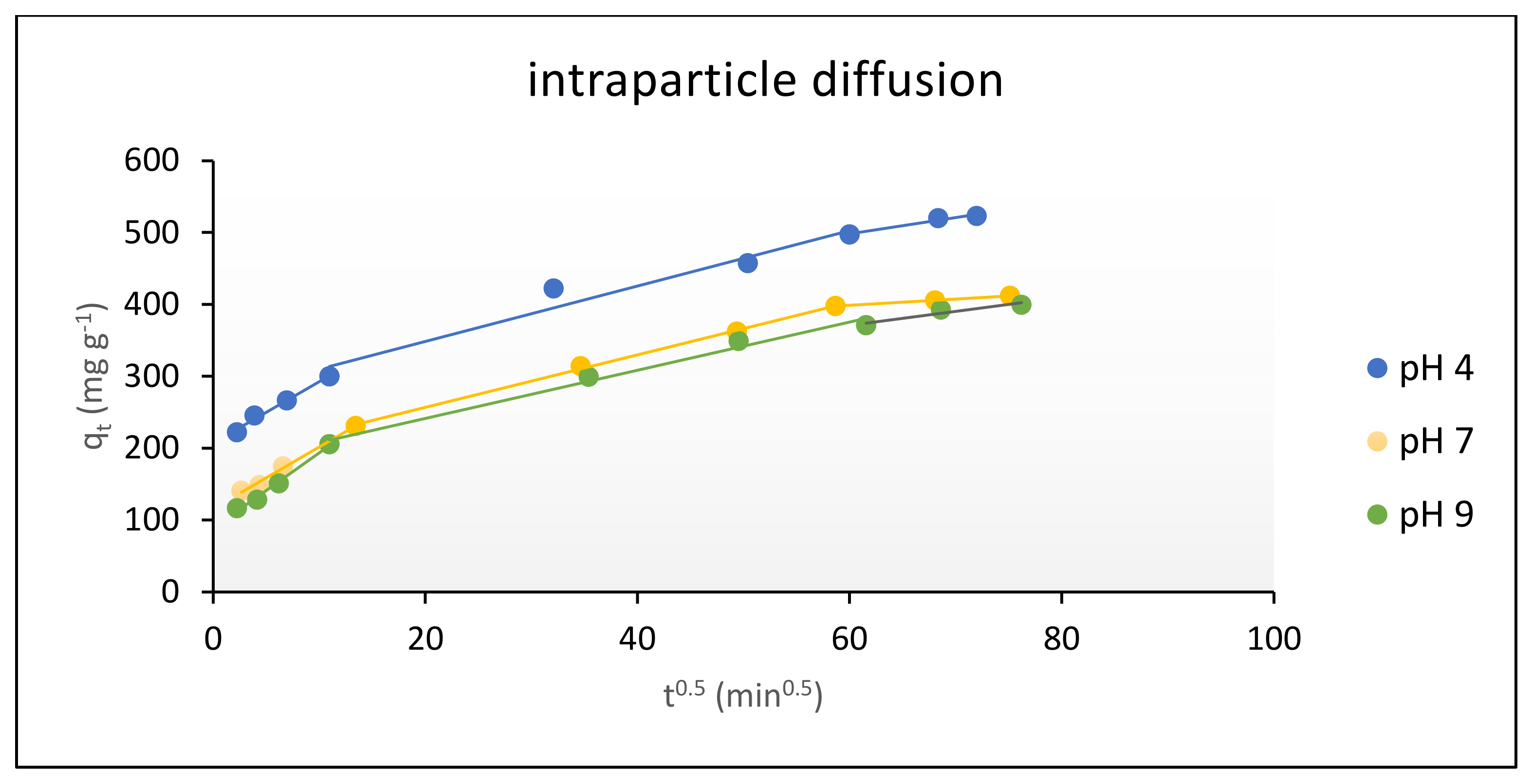
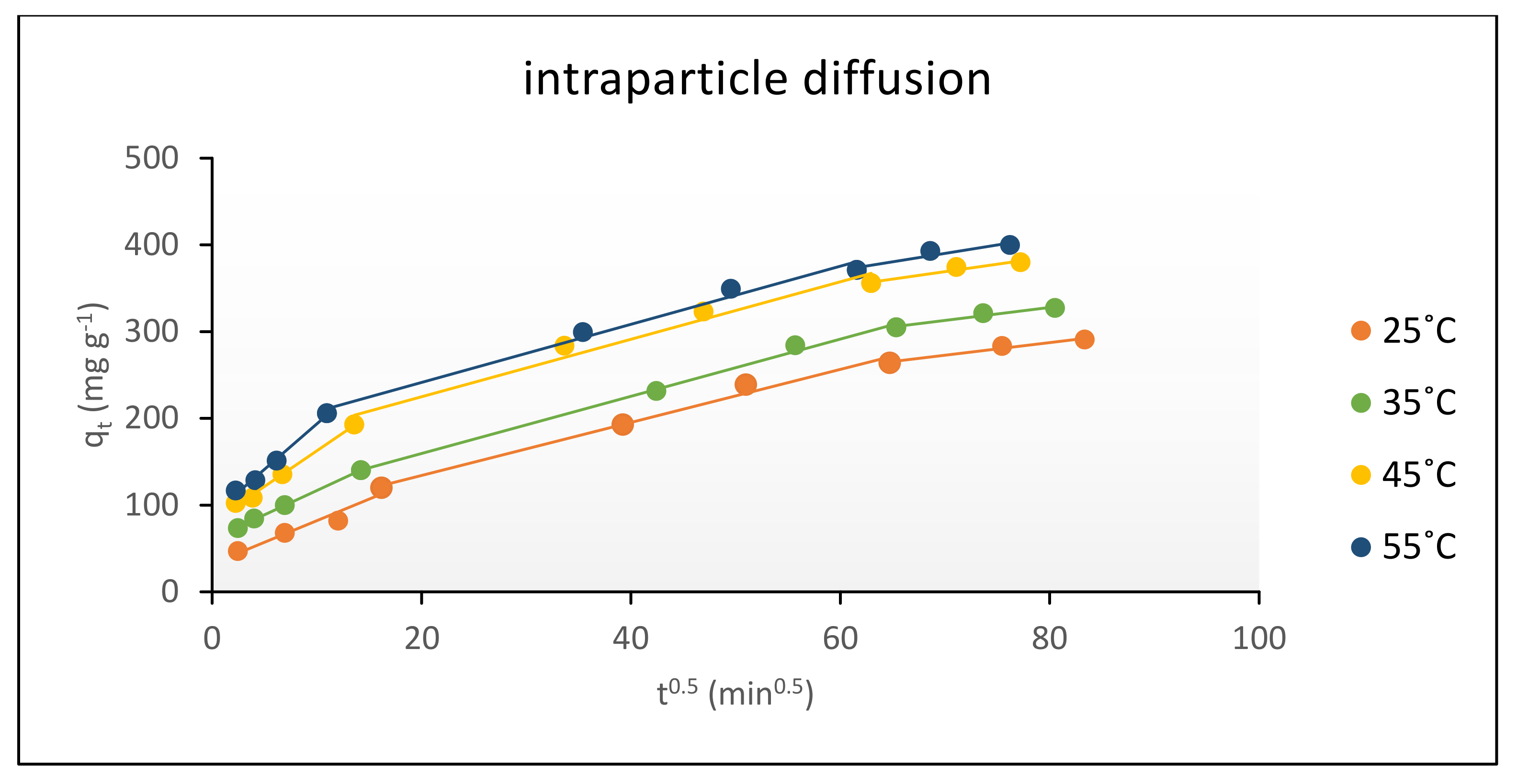



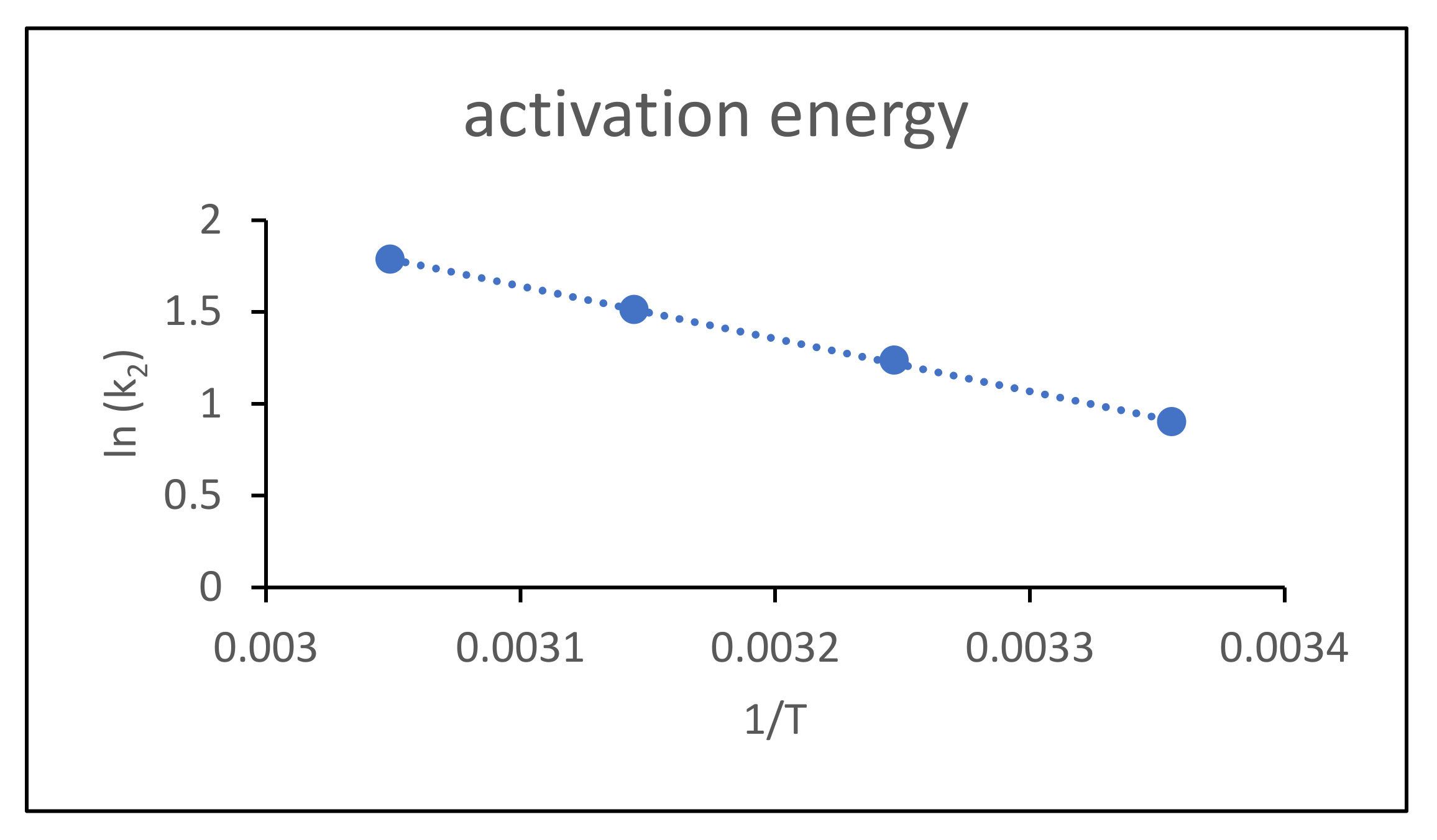
| Kinetic Models | Parameters | PH | ||
|---|---|---|---|---|
| 4 | 7 | 9 | ||
| qe.exp (mg g−1) | 523.33 | 412 | 399.78 | |
| pseudo- first-order | R2 | 0.934 | 0.988 | 0.969 |
| qe.cal (mg g−1) | 289.27 | 253.16 | 258.82 | |
| K1 (10−4) (min−1) | 9.21 | 6.91 | 6.91 | |
| Δqe (%) | 15.81 | 13.36 | 12.47 | |
| pseudo- second-order | R2 | 0.996 | 0.996 | 0.995 |
| qe.cal (mg g−1) | 526.32 | 416.67 | 400 | |
| K2 (10−5) (g mg−1 min−1) | 1.82 | 1.72 | 1.71 | |
| Δqe (%) | 0.201 | 0.400 | 0.019 | |
| Elovich | R2 | 0.967 | 0.975 | 0.976 |
| β (g mg−1) | 0.0219 | 0.0228 | 0.0233 | |
| α (mg g−1 min−1) | 573.41 | 78.52 | 60.75 | |
| Kinetic Models | Parameters | Temperatures | |||
|---|---|---|---|---|---|
| 25 °C | 35 °C | 45 °C | 55 °C | ||
| qe.exp (mg g−1) | 290.67 | 327.11 | 379.78 | 399.78 | |
| pseudo-first-order | R2 | 0.987 | 0.979 | 0.975 | 0.969 |
| qe.cal (mg g−1) | 229.88 | 250.78 | 251.88 | 258.82 | |
| K1 (10−4) (min−1) | 4.61 | 6.91 | 6.91 | 6.91 | |
| Δqe (%) | 7.39 | 8.25 | 11.91 | 12.47 | |
| pseudo-second-order | R2 | 0.990 | 0.990 | 0.995 | 0.995 |
| qe.cal (mg g−1) | 294.12 | 333.33 | 384.62 | 400.0 | |
| K2 (10−5) (g mg−1 min−1) | 0.90 | 1.24 | 1.54 | 1.71 | |
| Δqe (%) | 0.42 | 0.67 | 0.45 | 0.02 | |
| Elovich | R2 | 0.922 | 0.951 | 0.970 | 0.976 |
| β (g mg−1) | 0.026 | 0.0259 | 0.0235 | 0.0233 | |
| A (mg g−1 min−1) | 6.55 | 18.69 | 40.65 | 60.75 | |
| Kinetic Models | Parameters | Dye Concentrations | |||
|---|---|---|---|---|---|
| 400 mg L−1 | 500 mg L−1 | 600 mg L−1 | 1000 mg L−1 | ||
| qe.exp (mg g−1) | 382.0 | 453.56 | 523.33 | 624.67 | |
| pseudo- first-order | R2 | 0.988 | 0.980 | 0.934 | 0.953 |
| qe.cal (mg g−1) | 219.43 | 258.40 | 289.27 | 312.32 | |
| K1 (10−4) (min−1) | 6.91 | 6.91 | 9.21 | 9.21 | |
| Δqe (%) | 16.09 | 16.26 | 15.81 | 17.68 | |
| pseudo- second-order | R2 | 0.995 | 0.995 | 0.996 | 0.997 |
| qe.cal (mg g−1) | 384.62 | 454.55 | 526.32 | 625.0 | |
| K2 (10−5) (g mg−1 min−1) | 2.46 | 2.20 | 1.82 | 1.46 | |
| Δqe (%) | 0.26 | 0.08 | 0.20 | 0.019 | |
| Elovich | R2 | 0.965 | 0.964 | 0.967 | 0.966 |
| β (g mg−1) | 0.0274 | 0.0235 | 0.0219 | 0.0201 | |
| α (mg g−1 min−1) | 183.53 | 263.83 | 573.41 | 1765.75 | |
| Parameters | PH | |||
|---|---|---|---|---|
| 4 | 7 | 9 | ||
| Whole Processes | R2 | 0.969 | 0.960 | 0.961 |
| ki | 4.22 | 3.86 | 3.86 | |
| 1st | Ki.1 | 9.15 | 8.84 | 8.80 |
| 2nd | Ki.2 | 3.85 | 3.65 | 3.35 |
| 3rd | Ki.3 | 0.92 | 0.91 | 0.91 |
| Parameters | Temperatures | ||||
|---|---|---|---|---|---|
| 25 °C | 35 °C | 45 °C | 55 °C | ||
| Whole Processes | R2 | 0.971 | 0.984 | 0.953 | 0.961 |
| ki | 3.12 | 3.35 | 3.76 | 3.86 | |
| 1st | Ki.1 | 3.64 | 5.82 | 7.69 | 8.80 |
| 2nd | Ki.2 | 3.06 | 3.30 | 3.31 | 3.35 |
| 3rd | Ki.3 | 0.87 | 0.87 | 0.90 | 0.91 |
| Parameters | Dye Concentrations (mg L−1) | ||||
|---|---|---|---|---|---|
| 400 | 500 | 600 | 1000 | ||
| Whole processes | ki | 3.42 | 3.86 | 4.22 | 4.22 |
| 1st | Ki.1 | 6.40 | 7.68 | 9.15 | 10.04 |
| 2nd | Ki.2 | 3.21 | 3.62 | 3.85 | 4.17 |
| 3rd | Ki.3 | 1.14 | 1.04 | 0.92 | 0.45 |
| Isotherm Model | Parameters | |
|---|---|---|
| Langmuir | R2 | 0.993 |
| KL (L mg−1) | 0.033 | |
| qmax (mg g−1) | 434.78 | |
| RL | 0.070–0.032 | |
| Freundlich | R2 | 0.891 |
| Kf (L mg−1) | 203.41 | |
| 1/n | 0.114 | |
| Temkin | R2 | 0.876 |
| KT (L mg−1) | 33.54 | |
| B (J mol−1) | 42.34 | |
| D-R | R2 | 0.732 |
| Xmax (mg g−1) | 394.85 | |
| β (mol2 J−2) | 0.0001 | |
| E (kJ mol−1) | 0.07 |
| Thermodynamic Parameters | Temperature (K) | |
|---|---|---|
| ∆G° (KJ mol−1) | 298 | 0.15 |
| 308 | −0.46 | |
| 318 | −1.44 | |
| 328 | −1.89 | |
| ΔH° (kJ mol−1) | 21.37 | |
| ΔS° (J K−1 mol−1) | 71.17 | |
| Adsorbent | Adsorption Capacity (mg g−1) | Temperature °C | Dye Concentration mg L−1 | Adsorbent Dose (g) | pH | Ref. |
|---|---|---|---|---|---|---|
| Tunics of the corm of the saffron | 6.2 | 25 | 50–500 | 0.5 | 10 | [42] |
| Quaternized chitosan/chitosan cationic polyelectrolyte microsphere | 1500 | 25 | 0–1000 | 0.075 | 5 | [43] |
| Activated carbon coffee waste | 90.90 | 25 | 50 mg | 0.1 | 3 | [44] |
| xanthated chitosan/cellulose sponges | 289.855 | 30 | 6.25–200 | 0.05 | 6 | [45] |
| Chitosan and Laponite based nanocomposite | 390.3 | 30 | 500 | 1 | 6 | [46] |
| UCs | 624.67 | 55 | 1000 | 0.05 | 4 | Present study |
Publisher’s Note: MDPI stays neutral with regard to jurisdictional claims in published maps and institutional affiliations. |
© 2022 by the authors. Licensee MDPI, Basel, Switzerland. This article is an open access article distributed under the terms and conditions of the Creative Commons Attribution (CC BY) license (https://creativecommons.org/licenses/by/4.0/).
Share and Cite
Al-Harby, N.F.; Albahly, E.F.; Mohamed, N.A. Synthesis and Characterization of Novel Uracil-Modified Chitosan as a Promising Adsorbent for Efficient Removal of Congo Red Dye. Polymers 2022, 14, 271. https://doi.org/10.3390/polym14020271
Al-Harby NF, Albahly EF, Mohamed NA. Synthesis and Characterization of Novel Uracil-Modified Chitosan as a Promising Adsorbent for Efficient Removal of Congo Red Dye. Polymers. 2022; 14(2):271. https://doi.org/10.3390/polym14020271
Chicago/Turabian StyleAl-Harby, Nouf F., Ebtehal F. Albahly, and Nadia A. Mohamed. 2022. "Synthesis and Characterization of Novel Uracil-Modified Chitosan as a Promising Adsorbent for Efficient Removal of Congo Red Dye" Polymers 14, no. 2: 271. https://doi.org/10.3390/polym14020271
APA StyleAl-Harby, N. F., Albahly, E. F., & Mohamed, N. A. (2022). Synthesis and Characterization of Novel Uracil-Modified Chitosan as a Promising Adsorbent for Efficient Removal of Congo Red Dye. Polymers, 14(2), 271. https://doi.org/10.3390/polym14020271







